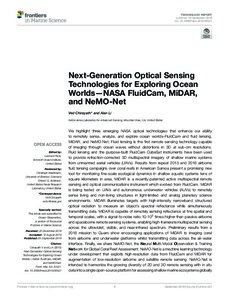Next-Generation Optical Sensing Technologies for Exploring Ocean Worlds—NASA FluidCam, MiDAR, and NeMO-Net.

View/
Average rating
votes
Date
2019Author
Chirayath, Ved
Li, Alan
Metadata
Show full item recordAbstract
We highlight three emerging NASA optical technologies that enhance our ability
to remotely sense, analyze, and explore ocean worlds–FluidCam and fluid lensing,
MiDAR, and NeMO-Net. Fluid lensing is the first remote sensing technology capable
of imaging through ocean waves without distortions in 3D at sub-cm resolutions.
Fluid lensing and the purpose-built FluidCam CubeSat instruments have been used
to provide refraction-corrected 3D multispectral imagery of shallow marine systems
from unmanned aerial vehicles (UAVs). Results from repeat 2013 and 2016 airborne
fluid lensing campaigns over coral reefs in American Samoa present a promising new
tool for monitoring fine-scale ecological dynamics in shallow aquatic systems tens of
square kilometers in area. MiDAR is a recently-patented active multispectral remote
sensing and optical communications instrument which evolved from FluidCam. MiDAR
is being tested on UAVs and autonomous underwater vehicles (AUVs) to remotely
sense livi.....
Journal
Frontiers in Marine ScienceVolume
6Issue
Article 521Page Range
24pp.Document Language
enSustainable Development Goals (SDG)
14.AMaturity Level
TRL 8 Actual system completed and "mission qualified" through test and demonstration in an operational environment (ground or space)Best Practice Type
Manual (incl. handbook, guide, cookbook etc)DOI Original
10.3389/fmars.2019.00521Citation
Chirayath, V. and Li, A. (2019) Next-Generation Optical Sensing Technologies for Exploring Ocean Worlds—NASA FluidCam, MiDAR, and NeMO-Net. Frontiers in Marine Science, 6:521, 24pp. DOI: 10.3389/fmars.2019.00521Collections
The following license files are associated with this item:
 Repository of community practices in Ocean Research, Applications and Data/Information Management
Repository of community practices in Ocean Research, Applications and Data/Information Management
